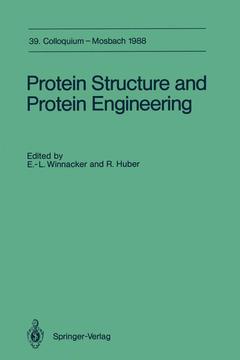Description
Protein Structure and Protein Engineering, Softcover reprint of the original 1st ed. 1988
Colloquium der Gesellschaft für Biologische Chemie in Mosbach Baden Series, Vol. 39
Coordinators: Winnacker Ernst-Ludwig, Huber Robert
Language: English
Subjects for Protein Structure and Protein Engineering:
Keywords
ATP; DNA; DNA sequencing; base; enzymes; mutagenesis; protein; reaction
Publication date: 10-2013
131 p. · 17x24.4 cm · Paperback
131 p. · 17x24.4 cm · Paperback
Description
/li>Contents
/li>
Protein engineering has had considerable impact on basic and applied research in biochemistry and molecular biology. It is already in use as a tool in molecular biology, but it is beginning to strongly influence the planning of experiments in biology everywhere, and, with even fur ther-reaching consequences, the appointment politics in research in stitutions and industries. Protein engineering, perhaps more than any other methods of protein analysis and peptide synthesis, has shown that proteins are organic molecules governed by the universal laws of chemistry and physics. How ever, as was the case with other new powerful methods and techniques, protein engineering tempts to an exploration of its limitations and thus generates more questions than it answers. The 39th Mosbacher Colloquium on Protein Structure and Protein Engi neering is not the first conference on this topic and it will not be the last. The important issues are obviously techniques of protein en gineering, examples of application, and the basic framework of protein structure and stability within which reasonable experiments can be de signed; conversely also, what we can learn about protein structure, dynamics, and folding from such experiments. Experiments in this direc tion aim at elucidating the folding code in the long run, but help to exploit the role of individual amino acid residues in catalysis, pro tein stability, and binding specificity in selected proteins now.
How Does ATP Make Work?.- Hydrophobic Interactions in Proteins.- Is There a Code for Protein Folding?.- The Method of Protein Structure Determination by NMR in Solution: Initial New Insights Relating to Molecular Mobility.- A Calculated Conformation for the Folding Transition State of Bovine Pancreatic Trypsin Inhibitor.- Conformational Entropy and Protein Stability.- The Improvement of Catalytic Effectiveness of an Enzyme: Pseudorevertant Triosephosphate Isomerases Obtained by Random Mutagenesis of Catalytically Sluggish Mutants.- Reaction Coordinate Approach to the Binding of Ligands to Carboxypeptidase A.- The Specific Interaction of Human Leukocyte Elastase with Various Protein Inhibitors.- The Interplay Between Enzyme Mechanism, Protein Structure, and Inhibitor and Catalyst Design.- Evolution of Hemoglobin as Studied by Protein Engineering and X-Ray Crystallography.- Design and Construction of Biologically Active Peptides and Proteins Including Enzymes.- Computer Modeling with a Protein Data Base.- Automated and High-Speed DNA Sequencing - Computer Technology Promotes Biological Advances.- Synthetic Antibodies with a Known Three-Dimensional Structure.
© 2024 LAVOISIER S.A.S.
These books may interest you

Folding of Disulfide Proteins 116.04 €



